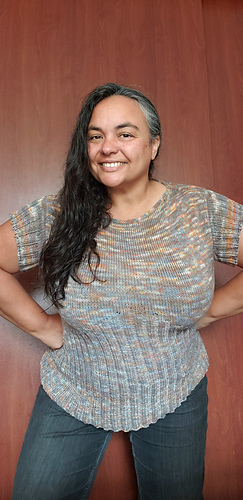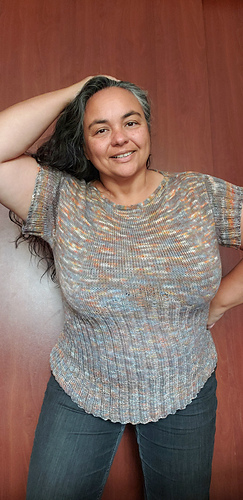patterns >  Sandra Mussons' Ravelry Store
Sandra Mussons' Ravelry Store
> Yes but also Top





































Yes but also Top
This design arose unexpectedly while I was going through a strong emotional process, the kind you experience when life shakes you, and I needed to find a space of peace and tranquility, where I could immerse myself without having to think, so, although I already had about 6 projects in progress, I decided to cast on one more, why not?, and thus this project was born, which is very simple, but, since you cannot fight against your own nature, which always ends up surfacing, It has a couple of little details that I like to make it interesting too, that’s why it’s called “Yes, but also”, because it has a simple look, but it also has its charm, it is relaxed, yes, but it could also be formal, depending on the yarn you choose, it has small sleeves, yes, but you could also make it long sleeved or sleeveless, making an icord edge.
Finally, it is a basic that you can easily adapt to your own taste without much fuss.
For my sample I used 450 meters of viscose in dk weight and 4.5mm needles, as I wanted it to have a lot of drape and be done quickly, in the end I knitted it in 48 hours!!!
NOTIONS:
- 400-750 meters (437 - 820 yd) of vegetal yarn (Rayón, Bamboo or sugar cane), in DK weight (200-400 grs).
- US 7 (4,5mm) circular needles or the size you need to get gauge, with 16” & 32” (40 y 80 cm) cable. If you use to have a tight gauge, consider to use needles one number bigger for icords.
- 1 soft waste yarn of 2 mt length
- 4 removable stitch markers (padlock kind).
- Tapestry needle to weave ends.
GAUGE:
17 sts x 19 rows in 10x10 cm. (4”x4”) in Stockinette st in flat.
SIZES:
Use your chest circumference (measure under your arms and over your bust) to choose your size. Ease is given by the own material grown.
If you want to use cotton yarn I suggest to choose one size bigger, because cotton doesn’t grow as much as the other fibers. (My size scale consider this growth).
The nomeclature for sizes will be:
1 (2, 3, 4, 5, 6) 7, 8, 9, 10, 11, 12.
85 (89, 94, 98, 102, 106) 110, 114, 118, 122, 126, 130 cm.
ESP
Este diseño surgió de forma inesperada mientras pasaba un proceso emocional fuerte, de esos que se viven cuando la vida te remece, y necesitaba encontrar un espacio de paz y tranquilidad, donde pudiera sumergirme sin necesidad de pensar, asi que, aunque tenia ya como 6 proyectos montados, me decidí a montar uno mas, porque no?, y así nació este proyecto que es muy sencillo, pero, como no se puede luchar contra la naturaleza propia, que siempre termina por aflorar, tiene un par de detallitos de esos que a mi me gustan para hacer que sea interesante también, por eso se llama “Si, pero también” porque es simple, pero también tiene su encanto, es relajado, si, pero también podría ser formal, dependiendo del hilado que elijas, tiene manguitas pequeñas, si, pero también podrías hacerlo manga larga o sin mangas, haciendo un borde de icord, en fin, es un básico que puedes acomodar fácilmente a tu propio gusto sin mucho rollo.
Para mi sample yo use 450 metros de viscosa en grosor dk y palillos de 4.5mm, ya que quería que tuviera mucha caída y que se hiciera rápido, al final lo teji en 48 horas!!!
MATERIALES:
- 400-750 metros de hilado vegetal, en grosor DK (200-400 grs).
- Palillos circulares de 4,5mm o de la medida que necesites para alcanzar la muestra, con cable de 80 y 40 cm. _ Ten a mano agujas circulares (o DPN) de un número más de lo que te indique tu tensión, en caso que tejas apretado, para hacer el icord.
- 1 trozo de Hilado suave de desecho de aproximadamente 2 metros de largo.
- 4 Marcadores de punto.
- Aguja lanera para esconder las hebras.
MUESTRA DE TENSIÓN:
En punto jersey en plano, bloqueado son 17 ptos x 19 filas en 10x10 cm.
TALLAS:
Puedes definir tu talla usando tu circunferencia de pecho, es decir la medida sobre el busto y bajo los brazos. La holgura esta dada por el crecimiento propio del material.
Por esto último, si quieres usar algodón te recomiendo elegir una talla más, por que el tallaje considera el crecimiento de la fibra que en las otras fibras vegetales es superior al algodón.
La nomenclatura para las tallas será:
1 (2, 3, 4, 5, 6) 7, 8, 9, 10, 11, 12.
85 (89, 94, 98, 102, 106) 110, 114, 118, 122, 126, 130 cm.
3178 projects
stashed
2900 times
- First published: January 2024
- Page created: January 21, 2024
- Last updated: July 30, 2025 …
- visits in the last 24 hours
- visitors right now





